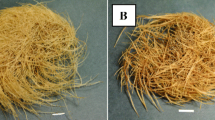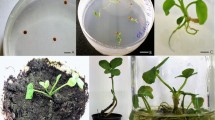Abstract
The present study is the first investigation of the inhibitory effect of Rhaponticum carthamoides transformed roots (TR) extract on the proliferation of grade II and III human glioma cells. TR extract showed the cytotoxic effect and inhibited the colony formation of both glioma cell lines in dose-dependent manner. The root extract induced apoptosis by increasing of the reactive oxygen species (about threefold compared to the control cells) leading to a disruption of mitochondrial membrane potential. Additionally, the mRNA levels of the apoptotic factors such as Bax, Tp53, caspase-3, and caspase-9 were observed to increase. These results indicate that the TR extract possesses anticancer activity by inhibiting glioma cell proliferation and inducing apoptotic cell death, and may be used as a promising anticancer agent.






Similar content being viewed by others
References
Huang W, Wang JY, Zhang D, Chen W, Hou L, Wu X, Lu Y (2015) Inhibition of KIF14 suppresses tumor cell growth and promotes apoptosis in human glioblastoma. Cell Physiol Biochem 37:1659–1670
Furnari FB, Fenton T, Bachoo RM, Mukasa A, Stommel JM, Stegh A, Hahn WC, Ligon KL, Louis DN, Brennan C, Chin L, DePinho RA, Cavenee WK (2015) Malignant astrocytic glioma: genetics, biology, and paths to treatment. Genes Dev 21:2683–2710
Walker C, Baborie A, Crooks D, Wilkins S, Jenkinson MD (2011) Biology, genetics and imaging of glial cell tumours. Br J Radiol 84:S90–S106
Ertosun MG, Rubin DLR (2015) Automated grading of gliomas using deep learning in digital pathology images: a modular approach with ensemble of convolutional neural networks. AMIA Annu Symp Proc 2015:1899–1908
Pistollato F, Bremer-Hoffmann S, Basso G, Cano SS, Elio I, Vergara MM, Giampieri F, Battino M (2016) Targeting glioblastoma with the use of phytocompounds and nanoparticles. Targ Oncol 11:1–16
Gali-Muhtasib H, Hmadi R, Kareh M, Tohme R, Darwiche N (2015) Cell death mechanism of plant-derived anticancer drugs: beyond apoptosis. Apoptosis 31:1531–1562
Darwiche N, El-Banna S, Gali-Muhtasib H (2007) Cell cycle modulatory and apoptotic effects of plant-derived anticancer drugs in clinical use or development. Exp Opin Drug Discov 2:361–379
Kokoska L, Janovska D (2009) Chemistry and pharmacology of Rhaponticum carthamoides: a review. Phytochemistry 70:842–855
Hamburger M, Gaube F, Wölfl S, Pusch L, Kroll T, Riese U, Schrenk D (2006) Effects of Leuzea carthamoides DC. on human breast cancer MCF-7 cells detected by gene expression profiling. Planta Med 72:992
Skała E, Sitarek P, Toma M, Szemraj J, Radek M, Nieborowska-Skorska M, Skorski T, Wysokińska H, Śliwiński T (2016) Inhibition of human glioma cell proliferation by alteredBax/Bcl-2-p53 expression and apoptosis induction by Rhaponticum carthamoides extracts from transformed and normal roots. J Pharm Pharmacol 68(11):1454–1464
Skała E, Kicel A, Olszewska MA, Kiss AK, Wysokińska H (2015) Establishment of hairy root cultures of Rhaponticum carthamoides (Willd.) Iljin for the production of biomass and caffeic acid derivatives. BioMed Res Int 2015:1–11
Puangpraphant SK, Potts G, de Mejia EG (2011) Diceffeoylquinic acids in Yerba mate (Ilex paraguariensis St. Hilaire) inhibit NF-ƘB nucleus translocation in macrophages and induce apoptosis by activating caspases-8 and -3 in human colon cancer cells. Mol Nutr Food Res 55:1509–1522
Rocha LD, Monteiro MC, Teodoro AJ (2012) Anticancer properties of hydroxycinnamic acids—a review. Cancer Clin Oncol 1:109–121
Szliszka E, Krol W (2013) Polyphenols isolated from propolis augment TRIAL-induced apoptosis in cancer cells. Evid Based Complement Altern Med 2013:1–10
Zhao X, Pang L, Li J, Song JL, Qin LH (2014) Apoptosis inducing effects of Kuding tea polyphenols in human buccal squamous cell carcinoma cell line BcacD885. Nutrients 6:3084–3100
Lloyd GB, McCown BH (1980) Commercially-feasible micropropagation of mountain laurel Kalmia latifolia by use of shoot-tip culture. Proc Int Plant Propagator’s Soc 30:421–427
Kleihues P, Louis DN, Scheithauer BW, Rorke LB, Reifenberger G, Burger PC, Cavenee WK (2002) The WHO classification of tumors of the nervous system. J Neuropathol Exp Neurol 61:215–225
Schmittgen TD, Livak KJ (2008) Analyzing real-time PCR data by the comparative CT. Method Nat Protoc 3:1101–1108
Szwed M, Laroche-Clary A, Robert J, Jóźwiak Z (2016) Efficacy of doxorubicin-transferrin conjugate in apoptosis induction in human leukemia cells through reactive oxygen species generation. Cell Oncol 39(2):107–118
Forbes-Hernández TY, Giampieri F, Gasparrini M, Mazzoni L, Quiles JL, Alvarez-Suarez JM, Battino M (2014) The effects of bioactive compounds from plant foods on mitochondrial function: a focus on apoptotic mechanism. Food Chem Toxicol 68:154–182
Halder B, Bhattacharaya U, Mukhopadhyay S, Giri AK (2008) Molecular mechanism of black Tea polyphenols induced apoptosis in human skin cancer cells: involvement of Bax translocation and mitochondria mediated death cascade. Carcinogenesis 29(1):129–138
Jung H, Bae J, Ko SK, Sohn UD (2016) Ultrasonication processed Panax ginseng berry extract induces apoptosis through an intrinsic apoptosis pathway in HepG2 cells. Arch Pharm Res 39:855–862
Chen M, Wang J (2002) Initiator caspases in apoptosis signaling pathways. Apoptosis 7(4):313–319
Kuno T, Tsukamoto T, Hara A, Tanaka T (2012) Cancer chemoprevention through the induction of apoptosis by natural compounds. J Biophys Chem 3(2):156–173
Steinbach JP, Weller M (2004) Apoptosis in gliomas: molecular mechanisms and therapeutic implications. J Neurooncol 70:245–254
Mishima S, Inoh Y, Narita Y, Ohta S, Sakamoto T, Araki Y, Suzuki KM, Akao Y, Nozawa Y (2005) Identification of caffeoylquinic acid derivatives from Brazilian propolis as constituents involved in induction of granulocytic differentiation of HL-60 cells. Bioorg Med Chem 13:5814–5818
Kurata R, Adachi M, Yamakawa O, Yoshimoto M (2007) Growth suppression of human cancer cells by polyphenolics from sweetpotato (Ipomoea batatas L.) leaves. J Agric Food Chem 55:185–190
Weng C, Yen G (2012) Chemopreventive effects of dietary phytochemicals against cancer invasion and metastasis: phenolic acids, monophenol, polyphenol, and their derivatives. Cancer Treat Rev 38:76–87
Tor YS, Yazan LS, Foo JB, Wibowo A, Ismail N, Cheah YK, Abdullah R, Ismail M, Ismail IS, Yeap SK (2015) Induction of apoptosis in MCF-7 cells via oxidative stress generation, mitochondria-dependent and caspase-independent pathway by ethyl acetate extract of Dillenia suffruticosa and its chemical profile. PLoS ONE 10(6):e0127441
Batra PB, Sharma AK (2013) Anti-cancer potential of flavonoids: recent trends and future perspectives. 3 Biotech 3:439–459. https://doi.org/10.1007/s13205-013-0117-5
Author information
Authors and Affiliations
Corresponding author
Ethics declarations
Conflict of interest
The authors declare that there is no conflict of interest regarding the publication of this paper.
Informed consent
Informed consent was obtained from patients included in this study.
Rights and permissions
About this article
Cite this article
Skała, E., Kowalczyk, T., Toma, M. et al. Induction of apoptosis in human glioma cell lines of various grades through the ROS-mediated mitochondrial pathway and caspase activation by Rhaponticum carthamoides transformed root extract. Mol Cell Biochem 445, 89–97 (2018). https://doi.org/10.1007/s11010-017-3254-z
Received:
Accepted:
Published:
Issue Date:
DOI: https://doi.org/10.1007/s11010-017-3254-z




